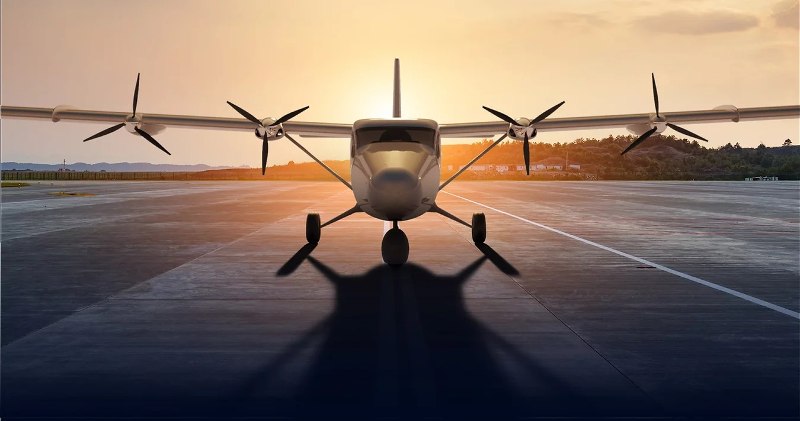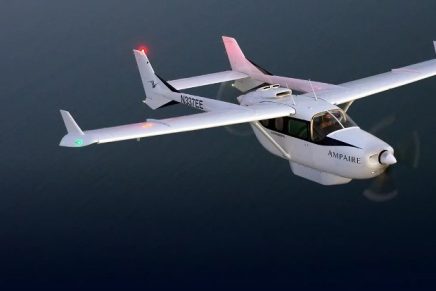Electric EEL Aircraft Shows the Real-World Capability of Hybrid-Electric Upgrades.
The Ampaire Electric EEL flew 1,075 miles (1730 km) nonstop on its journey to Oshkosh—a groundbreaking accomplishment for an electrified aircraft.
The Ampaire hybrid-electric EEL demonstrator aircraft completed a 1,880 statute mile mission from Los Angeles to Oshkosh, Wisconsin, where it was on display at EAA AirVenture’s most prominent location—Boeing Plaza. The journey included the single longest nonstop flight ever made by a hybrid-electric aircraft—1,135 miles.
Ampaire test pilot Elliot Seguin took off from Camarillo Airport on Wednesday afternoon, July 20 to reposition to Mojave Airport in California (85 miles) in order to avoid the potential for early morning fog the next morning. On Thursday, he flew the 1,135 miles from Mojave to Hays, Kansas. The next morning, July 22, he completed the trip, flying 660 miles to Oshkosh’s Wittman Regional Airport.
The EEL demonstrated fuel savings of up to 40 percent versus a standard Cessna Skymaster, on which it is based. The EEL is a parallel hybrid, with one conventional combustion engine and an independent electric drivetrain. Optimized hybrid electric aircraft can demonstrate substantially higher fuel savings and emissions reductions.
“By the time the EEL returns to California it will have flown more miles than any hybrid-electric aircraft, over 15,000, including airline demonstration flights in Hawaii and the UK. It is flying with great reliability and demonstrating the workhorse nature of hybrid-electric aircraft,” noted Dr. Susan Ying, Ampaire’s SVP of Global Partnerships.
“We are taking the technology and expertise developed with the electrical EEL and applying it to our first commercial product, the hybrid-electric nine-seat Eco Caravan regional aircraft, which will make its first flight later this year. That aircraft will demonstrate fuel savings up to 70 percent and emissions reductions up to 100 percent when using sustainable aviation fuel.” Ampaire is moving rapidly to bring the benefits of electrification to aviation markets, starting with the Eco Caravan and scaling its technology to larger regional aircraft.
Electric aviation pioneer Ampaire has secured a firm order backed by deposits for five of its low-emission, nine-seat Eco Caravan aircraft, plus an option for an additional 20.
The buyer is WingTips, an innovative air mobility company operating in California, Arizona, and Nevada. Both companies anticipate another 175 orders for the Eco Caravan as WingTips expands nationwide, plus 50 of Ampaire’s follow-on 19-seat Eco Otter aircraft.
WingTips plans to use these new aircraft on regional routes of 100 to 400 statute miles, flying mainly from convenient general aviation airports. The company uses artificial intelligence to offer individual seats to on-demand charter passengers, and advanced floating fleet algorithms to optimize fleet usage. The company also plans to offer scheduled service on higher volume routes.
“The Eco Caravan will redefine operating cost through its extreme efficiency,” said WingTips founder and CEO Mike Azzarello. “Our objective is to close the gap with the cost of driving while cutting travel time up to 75 percent. Working with Ampaire, we’ll be able to achieve this in a sustainable way. The Eco-Caravan operates within existing airport infrastructure, putting us years ahead of competitors that need major infrastructure investment in order to operate.”
“Ampaire and WingTips share a vision of reducing the cost and increasing the convenience of regional air travel while addressing a major source of harmful greenhouse gas emissions,” said Ampaire CEO Kevin Noertker. “The starting point for moving toward zero emissions is with low-emission hybrid-electric aircraft such as the Eco Caravan.”
The Eco Caravan is Ampaire’s first commercial product. It is a Cessna Grand Caravan upgraded with a hybrid-electric propulsion system that retains the range and payload characteristics of the current Grand Caravan. The Eco Caravan can carry up to eleven passengers or 2,500 pounds of cargo.
The aircraft uses 70 percent less fuel on short trips and 50 percent less on longer trips with corresponding emissions reductions. When using sustainable aviation fuel (SAF), emissions reduction is nearly 100 percent. Total operating cost reduction ranges from 25 to 40 percent, depending on route structure. The aircraft can operate independently of ground charging infrastructure by recharging the batteries in-flight when desired, as with hybrid-electric cars today.









